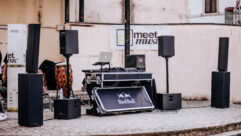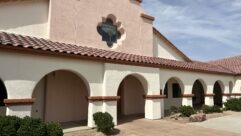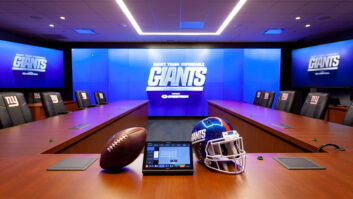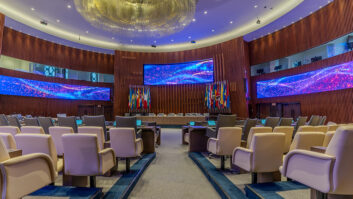In this edition of the SVC Podcast, Contributing Editor Bennett Liles talks with Duke DeJong of CCI Solutions in Olympia, Washington about the audio renovation they did for Calvary Community Church in nearby Sumner. The L-Acoustics WIFO system that was installed is replacing a sound setup that CCI Solutions had installed 15 years before. The church has seen many changes since then including multiple projection screens. The new speakers provided better sound coverage and improved sightlines.
Links of interest:
- CCI Solutions in Olympia, Washington
- L-Acoustics WiFo system installed for the church
- Symetrix provided signal processing for the new system
Download Podcast Here:
https://s3.amazonaws.com/nb-svc/public/public/183-1_Calvary_Comm_Church_…
This is the SVC Podcast from Sound & Video Contractor Magazine with Duke DeJong of CCI Solutions. You can find show notes and equipment links for the podcast on the web site of Sound & Video Contractor Magazine at svconline.com.
It’s an interesting experience when an AV contractor is called back to a church to upgrade an audio system that they installed, fifteen years before. CCI Solutions was called back to Calvary Community Church in Sumner, Washington to modernize and upgrade that system and Duke DeJong is here to give us the story. Right here on the SVC Podcast.
Alright, Duke. It’s good to have you back with us on the SVC Podcast. It’s been a little bit. Haven’t talked in a while.
Yeah, thanks for having me. I always have fun talking with you.
We’ve got the Calvary Community Church in Sumner, Washington to talk about which was an interesting retrofit for your guys. But since it’s been a while since we talked, tell us about what’s been going on at CCI Solutions.
Well, funny enough a lot of Calvary churches. This is one of somewhere in the neighborhood of 10 different Calvary churches we’re working with right now, so trying to keep them all straight has been fun. But we just continue to help churches all over the country with audio, video, lighting and acoustics and try to help them really connect well with people. And as you know, a lot of churches are struggling with old systems or poor acoustics and churches, their primary role is to communicate with people. So we have a lot of work to do with churches all over the place trying to help them communicate well with people in the room. [Timestamp: 1:44]
I know that can be a pretty tall order sometimes, particularly at smaller churches with growing needs and limited budgets. Do you find that churches have unique problems that tend to be the same ones over and over?
There definitely is a lot of consistency. We can pretty quickly walk into a room and tell kind of when it was built with most denominations because they ended up using the same architect who created a lot of the same problems. But you know, I think the biggest challenge as a whole with churches in general is they’re always really trying to fight the stewardship concept of how do we maximize every dollar we’re spending and how do we be extremely efficient? And all of those things inherently are good things. It’s just one of those things where they always have such high expectations and want so much, but the budget often isn’t quite there when it’s all based on donations. And always finding solutions that deliver good results at a very fair and reasonable price point is kind of the name of the game for us. [Timestamp: 2:40]
And this one wasn’t a brand new sanctuary where you might even get in on the building plans at the very beginning. You had to take out the old system first but I think in that part of it you had a little bit of an ace up your sleeve.
You know, a lot of times when we do a retrofit we kind of have to allow for a little bit of time for discovery to find out what don’t we know as we start to get in there. With these guys, though, we had a distinct advantage because 15 years ago or so their PA was put in by us. So they were overdue for an upgrade, but the same guy who was our project manager at the time and one of our lead installers at the time were able to work on this project again. And so the unknown was not a big topic for us this time because we knew what we were into and we already kind of knew what challenges we were running into walking in. So all in all yeah, it’s a church that’s grown a lot over the last decade or two. It’s a church that’s definitely changed its style and its approach to how they communicate with people. And their services definitely have more of a rock worship type of feel, they’ve got some really dynamic speaking, and their needs have changed dramatically from where they were 15 years ago. So it was time. It was time to bring in a system that would really hang in there with the performances, really the content they were throwing at it, and cover the room with not just good clarity but also warmth and fullness all the way down to the sub frequencies so they could really rock that room when they want to. [Timestamp: 4:06]
Of course it’s not every day that you take out your own old system but that for me would bring up the issue of how, as a contractor, how well you’ve documented everything especially after that much time has passed.
Sure. Yeah, I mean, you know, what’s always entertaining for us, especially up in the northwest where our office is headquartered, we’ll have churches 20 years ago that we worked on reach out to us and somewhere out in a warehouse we have boxes of all those files and documentation. We’ve tried to be good over the years of scanning some of the old stuff in, but some of that we just never got to and it’s still out there in a box. So fortunately out of our 41-year history we’ve got a pretty good history of documentation and as-builts, and a very poor history of cleaning out the closets. So we still own most of that stuff. Can’t always find it quickly, but we usually find it eventually. And even the older projects, we’ve got that stuff around. [Timestamp: 5:05]
Well, that place plays a number of roles during the week and has during the whole life of the building. Even though you probably knew the acoustics in there, was that place a converted gymnasium?
Yeah. Basically when they built it, it was really the – kind of the ultimate multipurpose room. I mean, even today they use it for many different functions. I mean they’ll use it for everything from kind of a conference center to, of course, their weekend worship. I don’t believe they’re using it much for sports any more, but when they built it, it was everything. I mean it was their weekend service gathering space. It was a gym during the week. It was conference center. It was – I mean it was everything. So it’s definitely still got that gym look and feel to it – in fact, I believe some of the baskets are still up – but I don’t think it’s been used that way much anymore. [Timestamp: 5:52]
Well who knows? With that progressive a church they might even work those into the services somehow.
Well, you can only hope. I mean, that would just be fun for me.
I looked at a video of this place. They don’t appear to use a podium like a more traditional church. They have mikes moving around and you never know where they might be.
And they’ve got some really great pastors on staff, very dynamic communicators. And because they are a multi-venue church, so they’ve got sites in different parts of the Seattle area. Video is really important to them, so I think their staff tends to be good about staying up on the stage, but I bet you during some of these events where they’re not video casting these things out they’re down on the floor walking amongst the people. [Timestamp: 6:30]
And for this I think you used the L-Acoustics ARCS WIFO speaker system and their scalable directivity must have helped get things right for the new setup.
It did. You know, for us we love the L-Acoustics product. There’s just a warmth and a clarity to those and just such great balance that we know that any customer who gets with an L-Acoustics system is going to be happy with how it sounds. So from there it’s just a matter of what’s going to cover their room and provide for us a plus or minus three decibel coverage throughout the entire seating space. And what the ARCS WIFO system allows us to do from front to back coverage wise is just fantastic. I mean, we are consistently able to throw those speakers into rooms that are 500-1,000 seats and really, really get just fantastic coverage from top to bottom. I mean they sound really great side to side with the box already, but any time you have any kind of array that top to bottom coverage definitely can kind of go sideways, especially as you get farther back in the room. And the way the Wide and the Focus boxes work together it just really gives us great coverage top to bottom. [Timestamp: 7:40]
It was a good while back when you put the original system in and I noticed that they have a lot of projection around the stage in there. Was that something they had in there then or has all of that been added since the original sound system was put in?
Oh no, that’s definitely something that’s been new in the last few years. The great news is 15 years ago speaker systems were much, much larger in general than they are today. And so the speakers that we took out of there were very large. In fact, they’ve been very affectionately named by our team “the refrigerators.” I think they were all roughly the size of a refrigerator each. But those were a custom-built cabinet that we used to make a couple of decades ago. And so really we were able to take down some very, very large boxes and replace them with these ARCS WIFO arrays. And so really, if anything, we’ve actually cut their footprint down, which is making their lighting and projection be able to work easier in that space. [Timestamp: 8:37]
Yeah, I’m sure they like having a sound system that better accommodates the visual elements and sometimes the contractor has to get a little creative in where they have to locate the amps and control. Had things changed on where you could locate the amp rack and that stuff?
No. I mean, fortunately with this one we already had a pre-set amp rack backstage and really it was just a matter of updating the equipment in it. Taking out the old stuff and putting in the new L-Acoustics amplifiers and the Symetrix DSP. And so by and large this one was a pretty easy one as far as implementation goes. We had a great design. Everything looked good on paper. We actually own a small demo rig for the ARCS WIFO and we were able to bring that out and let the church team get in front of it and listen to it. And they just fell in love with it and within a few months we had the new rig in and everybody has been really happy. [Timestamp: 9:30]
It doesn’t always go that way, but I’m glad it did with this one and next week we’ll get into more detail on how you actually did this and what came when. Thanks for getting with us and giving us the opening story on this project. It’s Duke DeJong from CCI Solutions in Olympia, Washington. Calvary Community Church was the project in, I believe it was in Sumner, right?
Yeah, Sumner, Washington.
Okay. And they’ve got a better sound system that your guys managed to get in there and slip in between Sundays. We’ll get more into this next week but thanks for being with us today.
Thank you.
Glad to have you along with us for the SVC Podcast. You can find show notes and equipment links for this one on the website of Sound & Video Contractor Magazine at svconline.com. Next week, Duke will tell us about finishing up the installation and tuning it for perfect sound. Be back with us for that on the next SVC Podcast.










